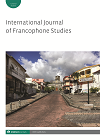-
f Year of the Typhus: Operation Torch through the eyes of Tunisian women, or how to make the Holocaust an Arab story?
- Source: International Journal of Francophone Studies, Volume 17, Issue 1, Mar 2014, p. 51 - 75
-
- 01 Mar 2014
Abstract
This article examines the plight of Tunisian ‘Arabs’ and ‘Jews’ during the critical period between 8 November 1942 and 20 May 1943 through the viewpoint of a local subaltern narrative, known in women’s oral history as Year of the Typhus. Relying on interviews conducted with World War II women survivors, family archives, war memoirs and other military correspondence by the Allies, this article presents four main arguments. First, both the Jew and the Arab appear as a dehumanized Oriental Otherness in the war diaries of the Anglo-American soldiers and war correspondents who were stationed in North Africa during Operation Torch. Second, both the Allies and the Axis Powers were anti-Semitic, not just the Nazis. Third, the chapter of the Holocaust in North Africa is not separate from European history of colonialism in Africa and the Middle East. Although today the word anti-Semitism includes only the ‘Jew’, World War II archives show that it included various ethnicities, namely, the Jew, the Arab, the Negro/Black and the Italian. Finally, the relations between ‘Jews’ and ‘Arabs’ during the war were governed by the racial and social hierarchy characterizing all colonized societies as well as by the French colonial politics of nativization and denativization. This hierarchal system shaped not only how these two groups viewed each other, but also how they viewed themselves.
Cet article examine la situation de la population tunisienne ‘juive’ et ‘arabe’ pendant la période critique entre le 8 novembre 1941 et le 20 mai 1943 à travers un référant narratif local appelé l’année du typhus dans l’histoire féminine orale et subalterne. En s’appuyant sur des interviews avec des survivantes de la deuxième guerre mondiale, les mémoires de guerre et autres correspondances militaires et médicales entre les alliés, cet article soutient quatre arguments majeurs. Le premier est la déshumanisation du juif et de l’arabe en tant qu’altérité orientale dans les carnets de guerre des soldats et correspondants de guerre Anglo-Américains stationnés en Afrique du Nord pendant Opération Torche. Deuxièmement, l’antisémitisme existait dans les deux camps, autant bien chez les alliés que les forces de l’axe. Troisièmement, dans le contexte Nord-Africain, le holocauste ne peut-pas être séparé de l’histoire du colonialisme européen en Afrique et au Moyen-Orient. Bien que le mot antisémitisme n’inclue que le ’juif’ aujourd’hui, les archives de la deuxième guerre mondiale démontrent qu’il incluait au passé non seulement le juif et l’arabe mais aussi l’Italien et le noir africain. En conclusion, les relations entre ‘juifs’ et ‘arabes’ étaient gouvernées par la hiérarchie raciale et sociale caractéristique de toute société colonisée ainsi que par la politique de dé-indigénisation et de ré-indigénisation poursuivie par la France coloniale. Cette hiérarchie coloniale a façonné non seulement l’image de l’autre, juif ou arabe, mais aussi l’image de soi.


